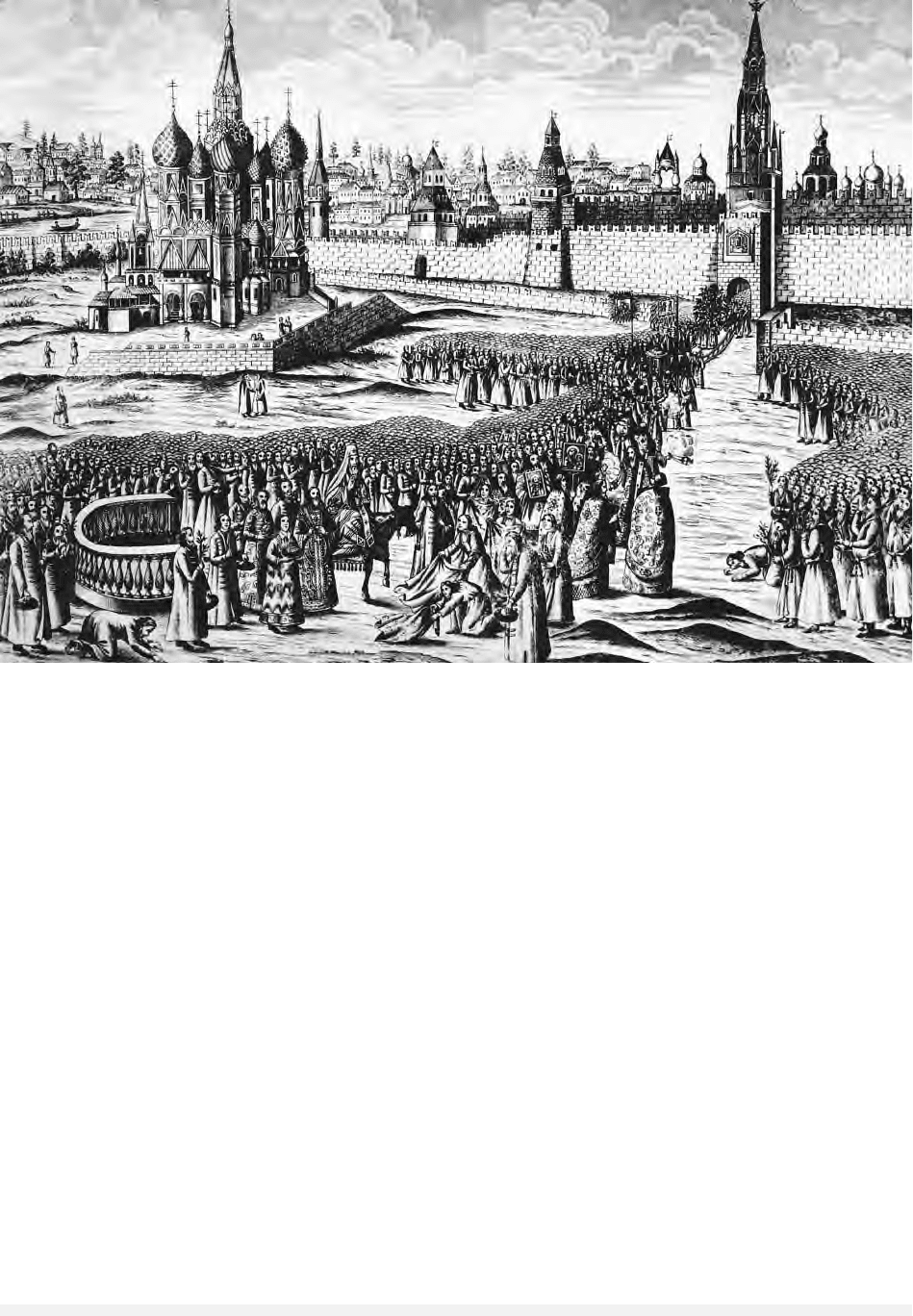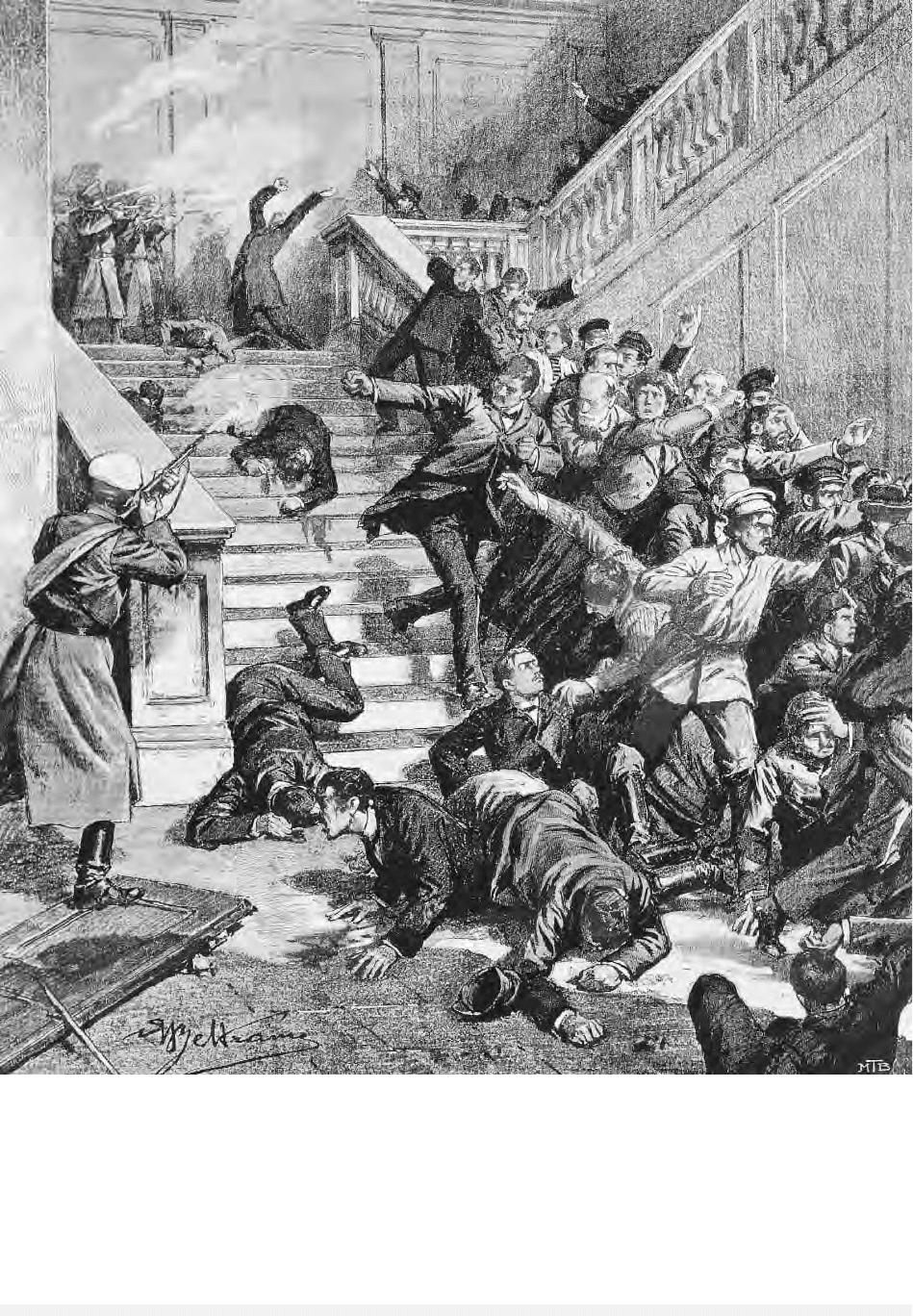Encyclopedia of Russian History
Подождите немного. Документ загружается.


and subjecting not only clergy but also believers to
repression. To no avail: The January 1937 census
revealed that 55.3 percent of those over age 14 de-
clared themselves believers. That impelled the regime
to redouble its efforts. In 1937–1941, hundreds of
thousands were arrested and large numbers exe-
cuted.
Although World War II forced the Stalinist
regime to tolerate the reestablishment of many re-
ligious organizations, these encountered growing
pressure that continued past Stalin’s death in 1953.
The post-Stalinist regimes proved indefatigable in
efforts to efface the remnants of superstition. They
did achieve a reduction in organized religion: the
number of religious organizations in the USSR de-
clined by a third (from 22,698 in 1961 to 15,202
in 1985).
Even if religious organizations had dwindled,
the government proved far less effective in com-
bating religious observance. Indeed, data from the
latter period of Soviet rule showed clear signs of
religious revival. In the case of baptism, for exam-
ple, even if the aggregate figures between 1979 and
1984 decreased (by 6.7%), authorities could not fail
to notice increases in some non-Russian republics
(19.9% in Georgia, for example) and even in the
RSFSR (1.5%). Baptism rates, moreover, skyrocketed
among non-Orthodox Christians, with increases of
43.6 percent among Lutherans, 33.3 percent
among Methodists, and 52.1 percent among Men-
nonites. Data about monetary contributions—an
increase of 17.8 percent between 1979 and 1984—
gave the regime further cause for worry. These
funds allowed established religions to bolster their
central administrations (45.9% of funds), expand
support for clergy (14.3%), and spend more on re-
ligious artifacts and literature (17.4%).
Mikhail Gorbachev’s perestroika in the mid-
1980s brought a significant improvement in the
RELIGION
1283
ENCYCLOPEDIA OF RUSSIAN HISTORY
Procession of clergy outside Moscow’s city walls, 1867. © A
USTRIAN
A
RCHIVES
/CORBIS

status and activism of religion. That, doubtless,
was a key factor behind the stunning 36.6 percent
increase in religious groups in the Soviet Union
(from 12,438 in 1985 to 16,990 in 1990); in the
RSFSR, the rate of growth was only slightly
slower—32.6 percent (from 3,003 in 1985 to 3,983
in 1990). The expansion of organized religion
hardly abated after the fall of the Soviet Union in
1991: In the Russian Federation, the number of reg-
istered religious organizations rose fivefold (to
20,200 on December 31, 2000).
That growth has been somewhat troubling for
the Russian Orthodox Church. Although a major-
ity of the citizens in the Russian Federation profess
some vague allegiance to Orthodoxy, observants
are relatively few (4.5%), and still fewer attend ser-
vices on a regular basis. Still more alarming has
been the exponential growth of non-Orthodox re-
ligious groups, especially Christian evangelical and
Pentecostal movements. In an effort to contain cult
movements, the law on religious organizations
(October 1997) posed barriers to the registration of
new religious groups, that is, those that had
emerged within the last fifteen years, chiefly from
foreign missions. Nevertheless, by the closing dead-
line for registration on December 31, 2000, Rus-
sian Orthodoxy claimed only a slight majority
(10,913) of the 20,200 religious organizations in
the Russian Federation; the rest consisted of Mus-
lim (3,048), Evangelicals (1,323), Baptists (975),
Evangelical Christians (612), Seventh-Day Adven-
tists (563), Jehovah’s Witnesses (330), Old Believ-
ers (278), Catholics (258), Lutherans (213), Jews
(197), and various smaller groups.
See also: CATHOLICISM; HAGIOGRAPHY; ISLAM; JEWS;
MONASTICISM; ORTHODOXY; PAGANISM; PROTES-
TANTISM; RUSSIAN ORTHODOX CHURCH; SAINTS
BIBLIOGRAPHY
Anderson, John. (1994). Religion, State, and Politics in the
Soviet Union and Successor States. New York: St. Mar-
tin’s Press.
Corley, Felix. (1996). Religion in the Soviet Union: An
Archival Reader. New York: New York University
Press.
Geraci, Robert P., and Khodarkovsky, Michael. (2001). Of
Religion and Empire: Missions, Conversion, and Toler-
ance in Tsarist Russia. Ithaca, NY: Cornell University
Press.
Hosking, Geoffrey A. (1991). Church, Nation, and State
in Russia and Ukraine. New York: St. Martin’s Press.
Lewis, David C. (1999). After Atheism: Religion and Eth-
nicity in Russia and Central Asia. New York: St. Mar-
tin’s Press.
G
REGORY
L. F
REEZE
RENOVATIONISM See LIVING CHURCH MOVEMENT.
REPIN, ILYA YEFIMOVICH
(1844–1930), Russia’s most celebrated realist painter.
The future master of realism, whose genius
with the canvas put him on par with the literary
and musical luminaries of Russia’s nineteenth cen-
tury, Ilya Yefimovich Repin arose from truly in-
auspicious surroundings. His father, a peasant, was
a military colonist in the Ukrainian (then, “Little
Russia”) town of Chuguev. His talent manifested
itself early, and at age twenty, he entered St. Pe-
tersburg’s Academy of Arts. His first major piece,
The Raising of Jarius’s Daughter, won him the gold
medal in academic competition, and with it, a
scholarship to study in France and Italy. Although
the Impressionists at that time were beginning their
critical reappraisal of representation, Repin re-
mained a realist, although his use of light shows
that he did not escape the influence of the new style.
Upon his return to Russia, he developed a nation-
alist strain in his paintings that reflected the polit-
ical mood of his era. In this work, he connected the
realism of style with that of politics, bringing his
viewers’ attentions to the arduous circumstances
under which so many of their fellow citizens la-
bored, reflected in his first major work beyond the
Academy, Barge Haulers on the Volga.
Although Repin was never specifically a polit-
ical activist, he was nonetheless involved with other
artists in challenging the conservative, autocratic
status quo. For example, he joined with other
painters who, calling themselves the peredvizhniki,
or “itinerants,” revolted against the system of pa-
tronage in the arts and circulated their works
throughout the provinces, bringing art to the emer-
gent middle classes. Moreover, they chose compo-
sitions that depicted their surroundings, as opposed
to the staid classicism of mythology; Repin shifted
from Jarius’s Daughter to Russian legends, exem-
plified by several versions of Sadko, a popular fig-
ure from medieval, merchant Novgorod. More
impressive, though, were those among his works
that evoked the reality of all aspects of contempo-
RENOVATIONISM
1284
ENCYCLOPEDIA OF RUSSIAN HISTORY

rary life, from the revolutionary movement to Rus-
sia’s colonial enterprise, from The Student-Nihilist to
The Zaporozhian Cossacks.
Repin also excelled as a portrait painter because
he was able to communicate the psychology of his
subjects. For example, his portrait of the tortured
Modest Mussorgsky stuns with its ability to bring
out varied aspects of the composer’s personality.
Repin’s oeuvre includes portraits of most promi-
nent liberals of his era, from Leo Tolstoy to Savva
Mamantov, as well as the archconservative Kon-
stantin Pobedonostsev. His paintings of historical
figures, Ivan the Terrible and His Son Ivan and
Tsarevna Sophia Alexeevna in the Novodevichy Con-
vent, likewise stand out for their capacity to evoke
the emotional.
Repin returned to the Academy of Arts in 1894,
directing a studio there until 1907 and serving
briefly as director (1898–1899). In 1900 he moved
to an estate in the Finnish village of Kuokalla, out-
side of St. Petersburg, where a constant stream of
visitors engendered a famously stimulating at-
mosphere. When Finland received its independence
from the Russian Empire in 1918, Repin chose to
remain there. The reacquisition of Kuokalla by the
Soviet army in 1939 resulted in the renaming of
the village to “Repino,” a museum to the artist.
See also: ACADEMY OF ARTS; NATIONALISM IN THE ARTS
BIBLIOGRAPHY
Parker, Fan and Parker, Stephen Jan. (1980). Russia on
Canvas: Ilya Repin. University Park: Pennsylvania
State University Press.
Sternin, Grigorii Iurevich, comp. (1987). Ilya Repin.
Leningrad: Aurora Publishers, 1987.
Valkenier, Elizabeth Kridl. (1990). Ilya Repin and the
World of Russian Art. New York: Columbia Univer-
sity Press.
L
OUISE
M
C
R
EYNOLDS
REPRESSED INFLATION
The Soviet State Price Committee (Goskomtsen) set
prices for 27 million products during the post
World War II era. It compiled data on the unit la-
bor and capital cost of each good, and added a profit
mark up. The resulting prime cost–based prices
were supposed to be permanently fixed, but many
were revised every decade or so to reflect changes
in labor and non-labor input costs. These adjust-
ments should have been small, because the state
raised wages gradually, and improved technologies
reduced material input costs. Some sectors like ma-
chine building, where productivity growth was
especially rapid, even reported falling unit input
costs, creating a condition called “repressed defla-
tion” during the interval between the establishment
of the initial price and its revision. Had the Soviet
Union been a competitive market economy, char-
acterized by rapid technological progress and state
wage fixing, strong deflationary pressures would
have caused prices to fall continuously.
However, many prominent Soviet economists
such as Grigoriy Khanin contend that it was infla-
tion, not deflation that was repressed by the Soviet
brand of price fixing. They argue that while prices
were supposed to be fixed, enterprise managers
driven by a desire to maximize bonuses tied to prof-
its, circumvented the authorities, causing interme-
diate input prices and therefore unit costs to rise.
Had the Soviet Union been a competitive market
economy, strong cost-push inflationary pressures
would have forced prices to steadily rise.
Some Soviet economists, such as Igor Birman,
have claimed that repressed inflation was exacer-
bated by weak monetary discipline and soft bud-
getary constraints, which allowed firms to spend
more than they were authorized. The purchasing
power of these offending enterprises, and of the
public, therefore exceeded the cost of goods sup-
plied. This created inflationary excess demand that
was easily observed in empty shop shelves, rapidly
increasing savings deposits, and the public convic-
tion that money was worthless because there
weren’t enough things to buy.
The evidence for this position is inconclusive,
because goods were often distributed in worker
canteens instead of shops, and there could have
been many alternative reasons why bank savings
rose. Nonetheless, the consensus holds that the
USSR was, in some important sense, an economy
of shortage, in a state of monetary disequilibrium
that subverted effective planning and contributed
to the system’s undoing. Although repressed infla-
tion may have seemed innocuous because Soviet
growth between 1950 and 1989 was always pos-
itive, most specialists consider it to have been an
insidious source of destabilization.
Repressed inflation was specific to the Soviet
period, and has not carried over into the post-
communist epoch, because prices are no longer
REPRESSED INFLATION
1285
ENCYCLOPEDIA OF RUSSIAN HISTORY

fixed or controlled. Price liberalization produced a
bout of hyper-inflation in 1992, only partly ex-
plained by the so-called Soviet “ruble overhang,”
but the problem subsequently subsided.
See also: ECONOMIC GROWTH, SOVIET; HARD BUDGET CON-
STRAINTS; MONETARY OVERHANG; RATCHET EFFECT
BIBLIOGRAPHY
Bornstein, Morris. (October 1978). “The Administration
of the Soviet Price System,” Soviet Studies 30(4):
466–490.
Grossman, Gregory. (1977). “Price Controls, Incentives
and Innovation in the Soviet Economy.” In The So-
cialist Price Mechanism, ed. Alan Abouchar. Durham,
NC: Duke University Press.
S
TEVEN
R
OSEFIELDE
REVOLUTION OF 1905
The immediate background to the first Russian rev-
olution, which, despite its designation as the “Rev-
olution of 1905,” actually began in 1904 and ended
in 1907, was the unexpected and humiliating de-
feat of Russia by the Japanese. The defeat embold-
ened the liberals, who in the fall and winter of
1904–1905 unleashed the so-called banquet cam-
paign for constitutional change. Meeting in twenty-
six cities, the liberals called for civil liberties,
amnesty for political prisoners, and a democrati-
cally elected constituent assembly. The banquets
were a prelude to the dramatic events of Bloody
Sunday (January 9, 1905), when government
troops fired on peaceful marchers (organized by Fa-
ther Gapon, founder of the Assembly of the Rus-
sian Factory and Mill Workers of the City of St.
Petersburg) who wished to present Tsar Nicholas II
(r. 1894–1917) with a petition for political and so-
cial reforms similar to those advocated by liberals
(significantly, without any demand for abolition of
the monarchy or introduction of socialism).
In light of the peaceful tactics and reformist
platform of the marchers, it is not surprising that
the massacre of 130 people and the wounding of
some three hundred provoked widespread outrage.
Within a few weeks, many industrial workers
throughout the empire went on strike to protest
the government’s conduct, assuming the role of a
viable political force for the first time. Students at
universities and high schools followed suit soon
afterward, disorders broke out among minorities
seeking cultural autonomy and political rights,
peasants attacked landlords’ estates, members of
the middle class defied governmental restrictions on
public meetings and the press, and on several oc-
casions soldiers and sailors mutinied. The entire
structure of society appeared on the verge of col-
lapse.
Incapable of coping with the growing unrest,
the government alternated between strident asser-
tions of the autocratic principle and vague promises
of reform, satisfying no one. The revolution peaked
in October, when a general strike, spontaneous and
unorganized, brought the government to its knees.
Once workers in Moscow walked off their jobs, the
strike spread quickly throughout the country, even
drawing support from various middle-class
groups. Numerous cities came to a standstill. Af-
ter about ten days, in mid-October, Tsar Nicholas,
fearing total collapse of his regime, reluctantly is-
sued the October Manifesto, which promised civil
liberties and the establishment of a legislature
(duma) with substantial powers. Most signifi-
cantly, the tsar agreed not to enact any law with-
out the approval of the legislature. In conceding
that he was no longer the sole repository of polit-
ical power, Nicholas did what he had vowed never
to do: He abandoned the principle of autocracy.
During the Days of Liberty, the period imme-
diately succeeding the issuance of the October Man-
ifesto, the press could publish whatever it pleased,
workers could form trade unions, and political par-
ties could operate freely. It was a great victory for
the opposition, but in a matter of days it became
evident that the revolutionary crisis had not been
overcome. The tsar made every effort to undo his
concessions. Large numbers of supporters of the
monarchy, enraged at the government’s conces-
sions, violently and indiscriminately attacked Jews
and anyone else deemed hostile to the old regime.
In the opposition, the St. Petersburg Soviet (coun-
cil of workers’ deputies) grew increasingly militant.
The upshot was that the Days of Liberty came to
an end within two months in a torrent of govern-
ment repression provoked by the uprising of
Moscow workers. Led by Bolsheviks and other rev-
olutionaries, this uprising was brutally quashed by
the authorities within ten days.
Nevertheless, the elections to the duma took
place. On the whole they proceeded fairly, with
some twenty to twenty-five million participant
voters. To the government’s surprise, the over-
REVOLUTION OF 1905
1286
ENCYCLOPEDIA OF RUSSIAN HISTORY

whelming majority of the elected deputies belonged
to opposition parties. The newly formed Octobrist
Party, satisfied with the political changes intro-
duced by the October Manifesto, held only thirteen
seats; the extreme pro-tsarist right held none. On
the other hand, the Kadets, or Constitutional De-
mocrats, who favored a parliamentary system of
government, held 185 seats, more than any other
REVOLUTION OF 1905
1287
ENCYCLOPEDIA OF RUSSIAN HISTORY
Massacre at Tiflis Municipal Council, October 1905. T
HE
A
RT
A
RCHIVE
/D
OMENICA DEL
C
ORRIERE
/D
AGLI
O
RTI
(A)

party, and dominated the proceedings of the legis-
lature. Predictably, relations between the Duma and
the government quickly soured because of the leg-
islature’s demands for a constitutional order and
for agrarian measures involving compulsory dis-
tribution of privately owned land to land-hungry
peasants. On July 1906 the government dissolved
the Duma. The deputies protested the action at a
meeting in Vyborg, Finland, and called for passive
resistance, but to no avail. The Second Duma,
which met on February 20, 1907, and was more
radical than the first, met a similar fate on June 3
of that year. This marked the end of the Revolu-
tion of 1905. At this point the authorities changed
the electoral law by depriving many peasants and
minorities of the vote, ensuring the election of a
conservative Duma.
Never before had any European revolution been
spearheaded by four popular movements: the mid-
dle class, the industrial proletariat, the peasantry,
and national minorities (who demanded autonomy
or, in a few cases, independence). But because of
the disagreements and lack of coordination among
the various sectors of the opposition, and because
the government could still rely on the military and
on financial support from abroad, the tsarist
regime survived. Nevertheless, Russia had changed
significantly between 1904 and 1907. The very ex-
istence of an elected Duma, whose approval was
necessary for the enactment of most laws, dimin-
ished the power of the tsar and the bureaucracy.
The landed gentry, the business class, and the up-
per stratum of the peasantry, all of whom contin-
ued to participate in the elections of the Duma, now
exercised some influence in public affairs. More-
over, trade unions and various associations of co-
operatives that had been allowed to form during
the revolutionary turbulence remained active, and
censorship over the press and other publications
was much less stringent. In short, Russia had taken
a modest step away from autocracy and toward
the creation of a civil society.
See also: AUTOCRACY; BLOODY SUNDAY; BOLSHEVISM;
CONSTITUTIONAL DEMOCRATIC PARTY; DUMA; LIBER-
ALISM; NICHOLAS II; OCTOBER GENERAL STRIKE OF 1905;
OCTOBER MANIFESTO; OCTOBRIST PARTY; WORKERS
BIBLIOGRAPHY
Ascher, Abraham. (1988–92). The Revolution of 1905. 2
vols. Stanford, CA: Stanford University Press.
Bushnell, John S. (1985). Mutineers and Repression: Sol-
diers in the Revolution of 1905–1906. Bloomington:
Indiana University Press.
Emmons, Terence. (1983). The Formation of Political Par-
ties and the First National Elections in Russia. Cam-
bridge, MA: Harvard University Press.
Engelstein, Laura. (1982). Moscow, 1905: Working-Class
Organization and Political Conflict. Stanford, CA:
Stanford University Press.
Harcave, Sidney. (1964). First Blood: The Russian Revolu-
tion of 1905. New York: Macmillan.
Mehlinger, Howard D. and Thompson, John M. (1972).
Count Witte and the Tsarist Government in the 1905
Revolution. Bloomington: Indiana University Press.
Sablinsky, Walter. (1976). The Road to Bloody Sunday: Fa-
ther Gapon and the St. Petersburg Massacre of 1905.
Princeton, NJ: Princeton University Press.
Surh, Gerald D. (1989). 1905 in St. Petersburg: Labor, So-
ciety and Revolution. Stanford, CA: Stanford Univer-
sity Press.
Verner, Andrew M. (1990). The Crisis of Russian Autoc-
racy: Nicholas II and the 1905 Revolution. Princeton,
NJ: Princeton University Press.
A
BRAHAM
A
SCHER
REYKJAVIK SUMMIT
A summit meeting of U.S. president Ronald Reagan
and Soviet leader Mikhail Gorbachev took place in
Reykjavik, Iceland, on October 11–12, 1986. This
second meeting of the two leaders was billed as an
“interim summit” and was not carefully prepared
and scripted in advance as was customary.
The Reykjavik summit unexpectedly became a
remarkable far-reaching exploration of possibilities
for drastic reduction or even elimination of nuclear
weapons. Gorbachev took the initiative, advancing
comprehensive proposals dealing with strategic of-
fensive and defensive weapons. Agreement seemed
at hand for reductions of at least 50 percent in
strategic offensive arms. When Reagan proposed a
subsequent elimination of all strategic ballistic
missiles, Gorbachev counterproposed eliminating
all strategic nuclear weapons. Reagan then said
he would be prepared to eliminate all nuclear
weapons—and Gorbachev promptly agreed.
This breathtaking prospect was stymied by dis-
agreement over the issue of strategic defenses. As
a condition of his agreement on strategic offensive
arms, Gorbachev asked that research on ballistic
missile defenses be limited to laboratory testing.
Reagan was adamant that nothing be done that
would prevent pursuit of his Strategic Defense Ini-
REYKJAVIK SUMMIT
1288
ENCYCLOPEDIA OF RUSSIAN HISTORY

tiative (SDI). The meeting ended abruptly, with no
agreement reached.
Many saw the failure to reach accord as a spec-
tacular missed opportunity, while others were re-
lieved that what they saw as a near disaster had
been averted. Subsequent negotiations built on the
tentative areas of agreement explored at Reykjavik
and led to agreements eliminating all intermediate-
range missiles (the INF Treaty in 1987) and reduc-
ing intercontinental missiles (the START I Treaty in
1991). Thus, although the Reykjavik summit ended
in disarray, in retrospect the exchanges there con-
stituted a breakthrough in strategic arms control.
See also: ARMS CONTROL; STRATEGIC ARMS LIMITATION
TREATIES; STRATEGIC DEFENSE INITIATIVE; UNITED
STATES, RELATIONS WITH
BIBLIOGRAPHY
Garthoff, Raymond L. (1994). The Great Transition: Amer-
ican-Soviet Relations and the End of the Cold War.
Washington, DC: The Brookings Institution.
Shultz, George P. (1993). Turmoil and Triumph: My Years
as Secretary of State. New York: Charles Scribner’s
Sons.
R
AYMOND
L. G
ARTHOFF
RIGA, TREATY OF (1921) See SOVIET-POLISH WAR.
RIGHT OPPOSITION
The Right Opposition, sometimes called Right De-
viation, represents a moderate strand of Bolshevism
that evolved from the New Economic Policy (NEP).
Headed by Nikolai Bukharin, the party’s leading
theoretician after Vladimir Ilich Lenin’s death, the
Right Opposition also included Alexei Rykov,
Mikhail Tomsky, Felix Dzerzhinsky, and A. P.
Smirnov. In part reacting against the harsh poli-
cies of War Communism, the right urged moder-
ation and cooperation with the peasantry to achieve
socialism gradually. It favored industrialization,
but at a pace determined by the peasantry, and pri-
oritized the development of light industry over
heavy industry.
Until early 1928 the platform of the right co-
incided with the policies of the Soviet government
and the Politburo. This is not surprising given that
Rykov was chairman of the Council of People’s
Commissars (Sovnarkom) from 1924 to 1930, and
Bukharin, Rykov, Tomsky, and their then ally
Josef Stalin held a majority in the Politburo until
1926. Participating in the struggles for power
following Lenin’s death, the right opposed Leon
Trotsky and his policies, as well as Grigory Zi-
noviev, Lev Kamenev, and eventually the United
Opposition. Toward the end of the 1920s, as Stalin
increasingly secured control over the party appa-
ratus, Trotsky, Zinoviev, and Kamenev were ex-
pelled from the Politburo and replaced by Stalin’s
handpicked successors, thereby enhancing the po-
sition of the right.
Their good fortune changed, however, follow-
ing the decisive defeat of the Left Opposition at the
Fifteenth Party Congress in December 1927. Hav-
ing supported Bukharin and the right’s position on
the cautious implementation of the NEP, Stalin, in
1928, abruptly reversed his position and adopted
the rapid industrialization program of the left. He
and his new majority in the Politburo then attacked
the Right Opposition over various issues including
forced grain requisitions, the anti–specialist cam-
paign, and industrial production targets for the
First Five–Year Plan. Outnumbered and unable to
launch a strong challenge against Stalin, the Right
Opposition sought an alliance with Kamenev and
Zinoviev, for which the Right Opposition was sub-
sequently denounced at the Central Committee
plenum in January 1929.
Under attack politically, Bukharin, Rykov, and
Tomsky signed a statement acknowledging their
“errors” that was published in Pravda in Novem-
ber 1929. Nonetheless, Bukharin was removed
from the Politburo that same month. The follow-
ing year Rykov and Tomsky were also expelled
from the Politburo. By the end of 1930 the trio was
removed from all positions of leadership, and mod-
erates throughout the party were purged; this of-
ficially marked the defeat of the Right Opposition.
Having already destroyed the Left Opposition,
Stalin was now the uncontested leader of the So-
viet Union.
The Great Purges of the late 1930s brought
further tragedy to the leaders of the defunct Right
Opposition. With his arrest imminent, Tomsky com-
mitted suicide in 1936. Two years later Bukharin
and Rykov were arrested and tried in the infamous
show trials of 1938. Despite the fact that they could
not possibly have committed the crimes that they
were accused of, and that their confessions were
clearly secured under torture, both were found
guilty and executed.
RIGHT OPPOSITION
1289
ENCYCLOPEDIA OF RUSSIAN HISTORY

See also: BUKHARIN, NIKOLAI IVANOVICH; LEFT OPPOSI-
TION; RYKOV, ALEXEI IVANOVICH; TOMSKY, MIKHAIL
PAVLOVICH; UNITED OPPOSITION
BIBLIOGRAPHY
Cohen, Stephen, F. (1973). Bukharin and the Bolshevik Rev-
olution: A Political Biography, 1888–1938. New York:
Oxford University Press.
Erlich, Alexander. (1960). The Soviet Industrialization De-
bate, 1924–1928. Cambridge, MA: Harvard Univer-
sity Press.
Merridale, Catherine. (1990). Moscow Politics and the Rise
of Stalin: The Communist Party in The Capital,
1925–32. New York: St. Martin’s Press.
K
ATE
T
RANSCHEL
RIMSKY-KORSAKOV, NIKOLAI
ANDREYEVICH
(1844–1908), prominent Russian composer who
contributed to the formation of a Russian national
music in the nineteenth century.
Nikolai Andreyevich Rimsky-Korsakov, a naval
officer by training, came to study professionally as
a member of Mily Balakirev’s amateur circle of
composers (“Mighty Handful”). An active composer
under Balakirev’s guidance since 1861, he became
a professor of composition and instrumentation
at the St. Petersburg conservatory ten years later.
Rimsky-Korsakov is regarded as one of the most
significant composers and musicians of Russia in
the nineteenth century.
Together with Balakirev and Alexander Bo-
rodin, who numbered among his closest creative
partners in the 1860s, Rimsky-Korsakov developed
a specific Russian idiom in orchestral music. As an
opera composer, although he wrote a few histori-
cal operas, Rimsky-Korsakov especially stands for
the Russian fairy and magic opera, the genre of
which he brought to a culmination. Of high though
not undisputed merit were the completions, revi-
sions, and instrumentations of opera torsos of
Borodin and Musorgsky, even if Rimsky-Korsakov
partly neglected the composers’ original intentions.
Finally, he made significant contributions to mu-
sical education. Not only did his textbook of har-
mony become the widely acknowledged standard
in Russia, but he also acted as a teacher and ex-
ample for outstanding Russian composers. His sup-
port of students in the Revolution of 1905 (leading
to his dismissal as professor) and his opera “The
Golden Cockerel” (1907), which was condemed by
censorship, because it could be interpreted as criti-
cism of tsarist rule, conributed to his renown and
reputation as an artist with political revolutionary
leanings. Furthermore, as one of the masters of
Russian national music in the nineteenth century,
he achieved enormous importance and influence in
the cultural history of the Soviet Union, particu-
larly since the cultural changes toward Great Russ-
ian patriotism under Stalin.
See also: MIGHTY HANDFUL; MUSIC; NATIONALISM IN THE
ARTS
BIBLIOGRAPHY
Seaman, Gerald R. (1988). Nikolai Andreevich Rimsky-
Korsakov: A Guide to Research. New York: Garland.
M
ATTHIAS
S
TADELMANN
RODZIANKO, MIKHAIL VLADIMIROVICH
(1859–1924), an anti-Bolshevik who led the con-
servative faction of the Octobrist Party in the pre-
revolutionary legislative Duma and served as
president of that body from 1911 to 1917, then
emigrated in 1920 to Yugoslavia, where he com-
pleted a memoir, The Reign of Rasputin.
Devoutly Orthodox, conservative, nationalist,
and loyal to the tsar, Mikhail Rodzianko also be-
lieved in the semiconstitutional system established
in 1906 and strove to make it work. He never
grasped that Nicholas II at heart rejected the new
order. The Duma leader was therefore always puz-
zled when the tsar ignored Rodzianko’s pleas to rid
the court of Rasputin’s pernicious influence and to
form a competent ministry.
An archetype of the old order, he came from a
prosperous landed family, received an elite educa-
tion, served in the army, and then became a dis-
trict marshal of nobility and zemstvo executive.
Chosen for the State Council in 1906 and elected to
the Third Duma in 1907, Rodzianko became Duma
president in 1911. He actively promoted the war
effort after 1914, and in 1916 warned the tsar that
incompetent ministers were undermining the
struggle against the Central Powers and endanger-
ing the survival of the monarchy itself.
During the Revolution of 1917, Rodzianko
urged the tsar to appoint a government in which
RIMSKY-KORSAKOV, NIKOLAI ANDREYEVICH
1290
ENCYCLOPEDIA OF RUSSIAN HISTORY

the people would have confidence and which he
hoped to head. As the revolution deepened he re-
luctantly agreed to help persuade Nicholas to ab-
dicate. Because of his political conservatism, he was
not asked, however, to serve in the new Provisional
Government.
As a believer in both the tsardom and consti-
tutionalism, he could only watch in dismay as Rus-
sia sank into radical revolution and civil war. In
emigration he found himself reviled by monarchists
as having betrayed the tsar, and rejected by liber-
als as having failed to be reformist enough.
See also: DUMA; NICHOLAS II; OCTOBRIST PARTY; REVO-
LUTION OF 1905
BIBLIOGRAPHY
Hasegawa, Tsuyoshi. (1981). The February Revolution,
Petrograd, 1917. Seattle: University of Washington
Press.
Hosking, Geoffrey. (1973). The Russian Constitutional Ex-
periment: Government and Duma, 1907-14. Cam-
bridge, UK: Cambridge University Press.
Rodzianko, Mikhail V. (1973). The Reign of Rasputin: An
Empire’s Collapse. Gulf Breeze, FL: Academic Interna-
tional Press.
J
OHN
M. T
HOMPSON
ROERICH, NICHOLAS
KONSTANTINOVICH
(1874–1947), artist, explorer, and mystic.
Born in St. Petersburg and educated at the
Academy of Arts, Roerich established himself as a
painter of scenes from Slavic prehistory. Works
such as The Messenger (1897), Visitors from Overseas
(1901–1902), and Slavs on the Dnieper (1905) com-
bined a bold use of color with Roerich’s expertise
as a semi-professional archaeologist. Roerich joined
the World of Art Group and designed sets and cos-
tumes for Sergei Diaghilev’s Ballets Russes. His
greatest fame resulted from his designs for Prince
Igor (1909) and The Rite of Spring (1913), the li-
bretto of which he cowrote with Igor Stravinsky.
In 1918, Roerich and his family left Soviet Rus-
sia for Scandinavia, England, then the United
States. In New York, Roerich and his wife, Helena,
founded a spiritual movement: Agni Yoga, an off-
shoot of Theosophy. Roerich’s followers included
Henry Wallace, Franklin Roosevelt’s secretary of
agriculture (and later vice-president). His backers
built a museum for him in Manhattan and spon-
sored him on two expeditions to Asia. From 1920
onward, Roerich’s painting took on an Asiatic,
mystical character, featuring gods, gurus, and Hi-
malayan mountainscapes.
Roerich visited India in 1923. From 1925 to
1928, he and his family completed a mammoth
trek through Ladakh, Chinese Turkestan, the Altai
Mountains, the Gobi Desert, and Tibet. Ostensibly
leading an American archaeological, ethnographic,
and artistic expedition, the Roerichs also secretly
visited Moscow, and the true purpose of their jour-
ney remains a matter of debate. Roerich established
a research facility in the Himalayan village of Nag-
gar, India, and lobbied for the passage of an inter-
national treaty to protect art in times of war. This
effort gained him two nominations for the Nobel
Peace Prize. In 1934–1935, Roerich, bankrolled by
Wallace and the U.S. government, traveled to
Manchuria and Mongolia. The expedition stirred up
great scandal, leading Wallace and most of
Roerich’s supporters to break with him by 1936.
Roerich’s U.S. assets were seized. The Roerichs re-
mained in India, supporting the freedom movement
there and befriending its leaders, such as poet Ra-
bindranath Tagore and Jawaharlal Nehru. Roerich
died in 1947. Nehru, the new leader of independent
India, gave his eulogy.
Roerich’s occultism and the mysteries sur-
rounding his expeditions have shaped both popu-
lar and academic understanding of his life. Western
scholars acknowledge the importance of his early
art, but have criticized his later works; they have
tended to be suspicious about the political and
mystical motives underlying his expeditions. After
the late 1950s, Soviet scholars reinstated Roerich
as an important figure in the Russian artistic
canon, but downplayed his occultism and contro-
versial actions. Non-academic writing on Roerich
is either hagiographic—Agni Yoga has a worldwide
following, and the Russian movement has enjoyed
tremendous popularity since 1987—or lurid and
sensationalistic, accusing Roerich of espionage and
collaboration with the Soviet secret police. Since
the early 1990s, emerging evidence indicates that
the Roerichs believed a new age was imminent
and that one of its necessary preconditions was
the establishment of a pan-Buddhist state linking
Siberia, Mongolia, Central Asia, and Tibet. The
Roerichs also sought to involve themselves in the
struggle between Tibet’s key political figures, the
Panchen (Tashi) Lama and Dalai Lama. Rather than
ROERICH, NICHOLAS KONSTANTINOVICH
1291
ENCYCLOPEDIA OF RUSSIAN HISTORY

straightforward espionage, the purpose of Roerich’s
expeditions seems to have been the fulfillment of
these grandiose, but ultimately quixotic, ambitions.
See also: BALLET; OCCULTISM
BIBLIOGRAPHY
Decter, Jacqueline. (1997). Messenger of Beauty: The Life
and Visionary Art of Nicholas Roerich. Rochester, VT:
Park Street Press.
McCannon, John. (2001). “Searching for Shambhala:
The Mystical Art and Epic Journeys of Nikolai
Roerich.” Russian Life 44(1):48–56.
Meyer, Karl, and Brysac, Shareen Blair. (1999). Tourna-
ment of Shadows: The Great Game and the Race for Em-
pire in Central Asia. Washington, DC: Counterpoint.
Williams, Robert C. (1980). Russian Art and American
Money: 1900–1940. Cambridge, MA: Harvard Uni-
versity Press.
J
OHN
M
C
C
ANNON
ROMANIA, RELATIONS WITH
Founded in the thirteenth and fourteenth centuries,
the principalities of Moldavia and Wallachia gained
their autonomy from the Hungarian kings with
the election of native princes. The status of these
principalities was comparable to that of the Grand
Duchy of Moscow, and they shared allegiance to
the patriarch of Constantinople. During the fif-
teenth century, the chief threat they faced was
Turkish expansionism in the Balkans. Their earli-
est contact with Moscow occurred when Ivan III
negotiated a marriage alliance with Steven the Great
of Moldavia (1457–1604). His daughter, Elena, be-
came the bride of Ivan the Young, whose son
Dmitry became heir to the throne.
THE LIBERATION OF ROMANIAN
LANDS FROM THE TURKS
As the power of the Romanian princes declined and
those of the grand dukes increased, the former tried
to switch their allegiance from Constantinople
to Moscow. Such contacts encouraged Nicholas
Milescu, a Moldavian boyar, to serve Tsar Alexei
as ambassador to China. The earliest attempt at
signing a treaty of alliance with Russia was made
by Prince Dmitry Cantemir of Moldavia, who in-
vited Peter the Great (r. 1682–1725) to deliver the
country from the Turks. The liberation failed with
Peter’s defeat on the River Pruth in 1711, but it
opened a career for Dmitry at St. Petersburg as a
Westernizer, and for his daughter, Maria, who ded-
icated herself to emancipating the Russian women.
The true liberator of Romanian lands was
Catherine the Great (r. 1762–1796) who, in three
campaigns against the Turks, reached the Dniester
River. The Treaty of Kutchuk Kainardji (1774) gave
Russia formal influence in the principalities, with
two consuls at Bucharest and Jassy. French inter-
ference with these provisions occasioned the Russo-
Turkish War of 1802–1812, which gave Russia the
Bessarabian half of Moldavia. Although the Greek
revolution of 1821 began in Moldavia, Tsar Alexan-
der I (r. 1801–1825) denounced it because of the
anti-revolutionary stance of the Holy Alliance (an
informal agreement among Christian monarchs to
preserve European peace). Russia’s greatest gain oc-
curred following the Treaty of Adrianopole, when
Tsar Nicholas I (r. 1825–1855) established a pro-
tectorate over both Romanian provinces, thus tak-
ing over the nominal Turkish suzerainty. Although
native Romanian princes continued to be elected,
power now resided with the two Russian procon-
suls who were headquartered in Bucharest and
Jassy.
Russia demanded that the new generations be
schooled at St. Petersburg, but Romanians preferred
the schools in Paris, where many of their young
people participated in the 1848 revolution against
the July monarchy. When they returned home and
attempted to continue that revolution in the Ro-
manian capitals, Russia suppressed the movement
and reoccupied the provinces under more stringent
conditions. The Congress of Paris, which followed
the Crimean War (1853–1856), suppressed the
Russian protectorate, internationalized Danubian
navigation, reunited Bessarabia with Romania, and
attempted to revise the constitution of both states.
The Romanians took the initiative of electing
Alexander Ion Cuza in 1859 as prince of the United
Principalities, as Moldavia and Wallachia were now
called, but this arrangement disturbed Austria and
Turkey more than it did Russia.
The overthrow of Cuza in a military coup, and
the advent of Prince Charles of Hohenzollern Sig-
maringen in 1866, was greeted positively by Aus-
tria after he visited Tsar Alexander II (r. 1855–1881)
at Livadia in 1869. The Bosnian crisis that led to the
Balkans war of independence (1877–1878) gave Rus-
sia the opportunity to avenge its defeat in 1856. Ini-
tially neutral during this war, Romania nonetheless
gave Russia a right of passage to Bulgaria, albeit with
misgivings. However, when Grand Duke Nicholas
ran into difficulties at Plevna, in Bulgaria, he ap-
ROMANIA, RELATIONS WITH
1292
ENCYCLOPEDIA OF RUSSIAN HISTORY
